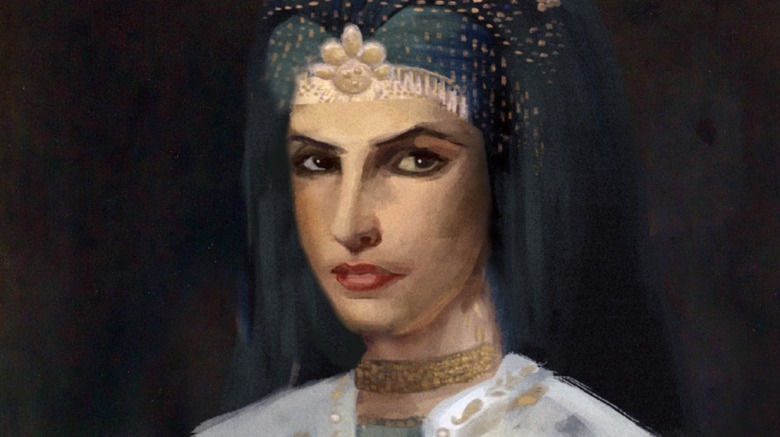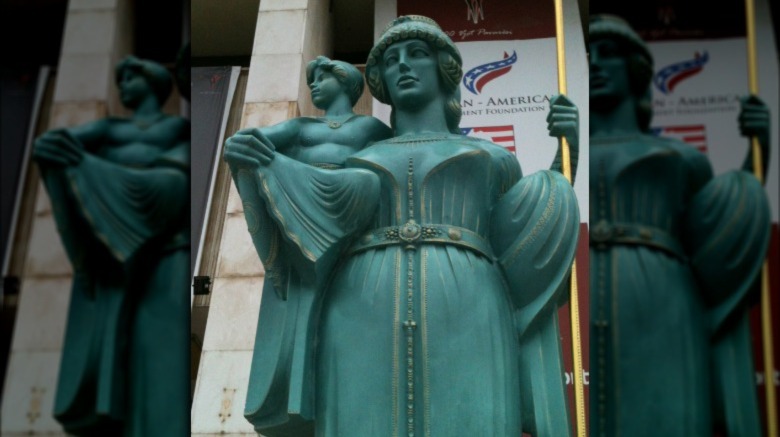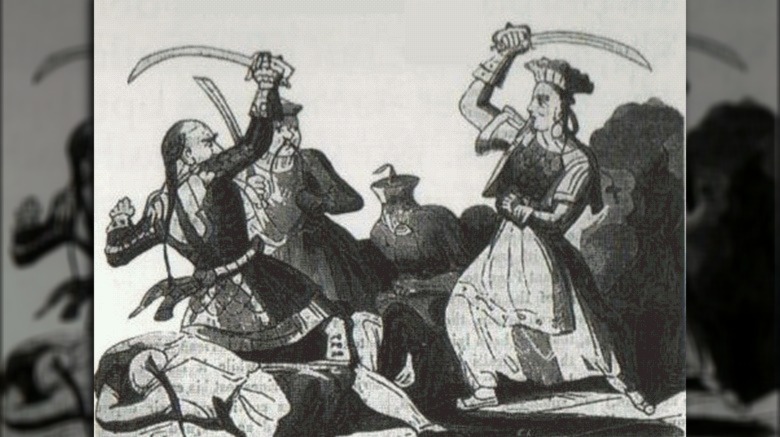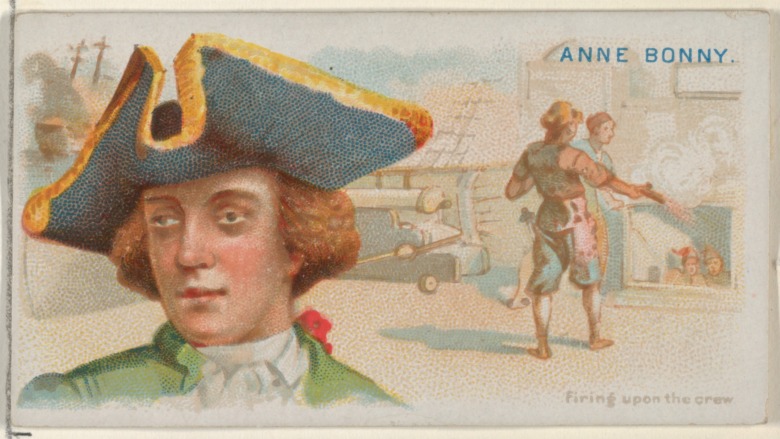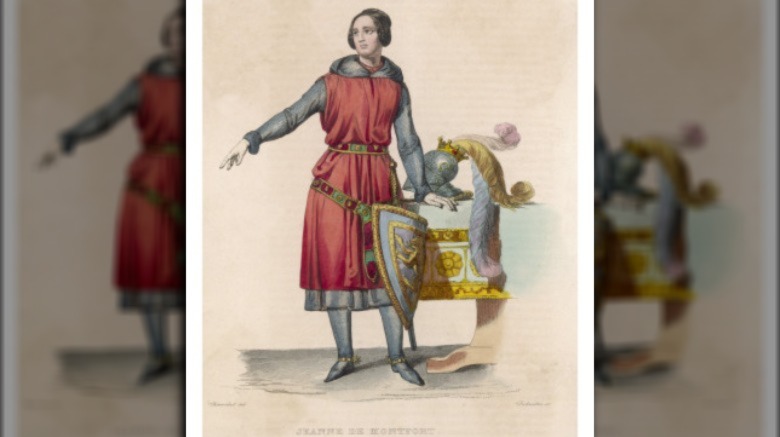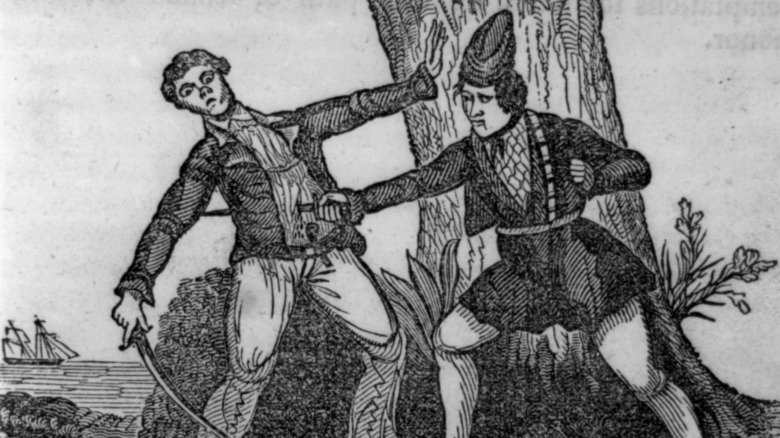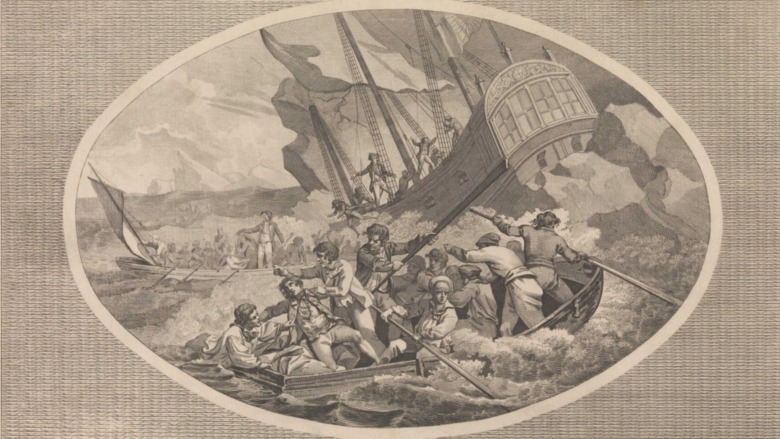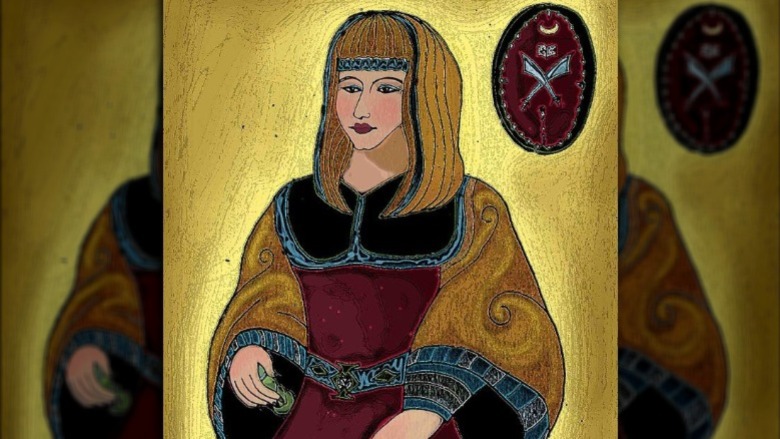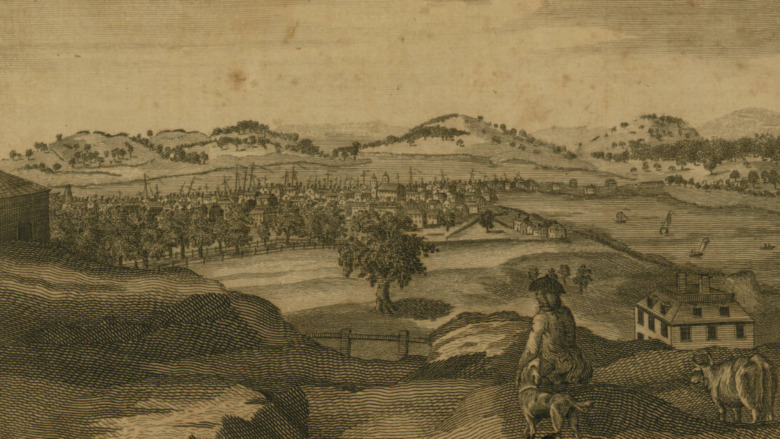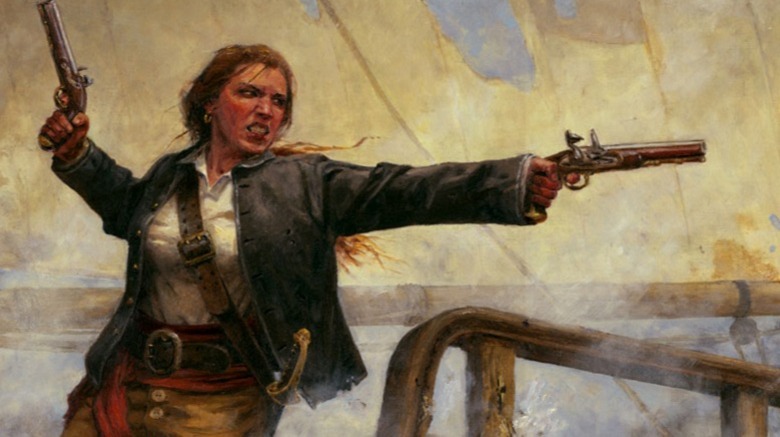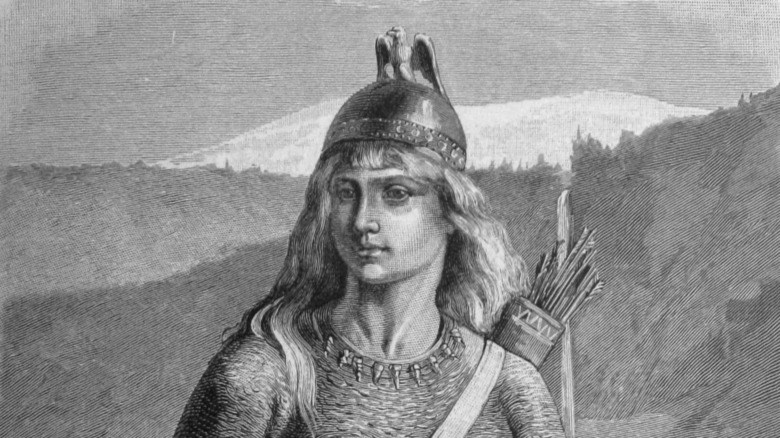These Are The Most Notorious Female Pirates In History
Picture the perfect pirate. He's probably pretty striking overall, maybe with a peg leg, a cool hat, and a visage that's weather-worn — the quintessential salty sea dog. This buccaneer and his ferocious crew spend their days attacking unwary ships, plundering the contents of their victims' vessels, drinking grog, and generally having a good time on the high seas.
Hold on, though. Who says that this pirate has to be a man? In fact, a quick look at history shows us that, not only were quite a few women part of the pirate life, but they have some deeply fascinating stories of their own. They also range across the globe and timespan of piracy, going far beyond the 18th century, Caribbean-based swashbuckling that's now famous as the Golden Age of Piracy.
As Smithsonian Magazine reports, most women encountered a pretty diverse set of circumstances within the world of pirates. Some were high-powered nobles who could set their own paths with private fleets of ships, while others were convicts who were put in adventure's path either by accident or their own design. Some concealed themselves as men, while many others lived openly as women. All of them have unique and exciting stories, not least because they were often daring people who defied gender standards to become some of the most notorious female pirates in history.
Teuta of Illyria was a pirate queen who tangled with Rome
As regent of the Ardiaean Kingdom in the 3rd century BCE, "Pirate Women" reports, Teuta of Illyria reportedly maintained a serious pirate fleet from her center of power, now in modern-day Albania. It was all in the service of a quest to enrich her kingdom and its people. She commanded her nation's pirates to plunder settlements both by land and sea, even hitting cities and states that were supposed to be friendly to Illyria.
It's said that Teuta wasn't content just to command pirates from a throne somewhere — she wanted to take part in the action herself. However, it's worth noting that much of the information we have about Teuta and her pirate fleet comes from the Romans, who weren't exactly friendly to the Illyrians. According to "Battle Cries and Lullabies," ancient Rome was provoked into action when Teuta's pirates attacked Roman vessels. It probably didn't help that, when earlier Roman ambassadors asked her to knock it off, she basically shrugged and said it was her people's custom to loot and pillage.
Hitting Roman vessels and the Roman economy pretty much spelled the end for the Ardiaean Kingdom, though it took over a decade and multiple battles to finally put down the pirate menace established by queen Teuta.
Cheng I Sao may have been the most successful pirate ever
According to JSTOR Daily, Cheng I Sao first came to prominence around 1795. Most accounts maintain that she was originally a sex worker who married a pirate and began accompanying her husband on his plundering expedition. The version of her story related by Atlas Obscura maintains that her pirate husband specifically sought her out because she had a reputation as a shrewd and canny businesswoman who knew how to gain power and intimidate people who contracted her services.
Ironically enough, her name translates to "Cheng I's wife," meaning that we don't have the actual name of one of the biggest pirates in history. That's even more ironic because Cheng I died in 1807, as JSTOR Daily reports. His wife quickly moved to secure the support of key pirate chiefs and maintain control over thousands of ships that carried up to 80,000 pirates. Cheng I Sao also implemented a strict code of conduct, with the death penalty applied for offenses like deserting, looting from the pirate treasury, or sexually assaulting women.
Perhaps the most astonishing part of Cheng I Sao's story is that she retired peacefully. Around 1810, she negotiated with Chinese officials to not only give her a fleet of ships and the go-ahead to work as a legitimate businesswoman, but to grant all her pirates clemency and even give them government jobs if they wished.
Anne Bonny led a notorious pirate life
Born in Ireland around 1698, Anne Bonny was active in the Caribbean during the 18th century, as Britannica reports. Though her time in the piratical spotlight was relatively short, she made such an impression that we're still talking about her centuries after her presumed death.
According to the National Park Service, Anne was the daughter of William Cormac, a lawyer, and Mary Brennan, his servant. Cut off by his wife, William took Mary and Anne to the British colony in Carolina, where he appears to have comfortably established himself as a businessman. Anne, therefore, was the daughter of a relatively privileged family, though her mother died when she was only 12. Eventually, she married a relatively small-potatoes pirate named James Bonny. The pair moved to the Bahamas, where Anne began to take up with the local pirate community and pirate "Calico Jack" Rackham in particular. Soon enough, Anne joined Calico Jack's crew and began working as a pirate herself.
Things must have seemed pretty exciting until 1720, when Calico Jack's crew was caught, tried in Jamaica, and sentenced to hang. Anne reportedly revealed her gender and "pled the belly," claiming that she was pregnant and so couldn't be executed. The stay was seemingly granted, but then Anne disappears from the record. Some assume that she gave birth and then was executed, while others maintain that she returned to her father in the Carolinas.
Jeanne de Clisson took up piracy as revenge
Called the "Lioness of Brittany," Jeanne de Clisson was a 14th century noble wasn't out for plunder or even for fame. Instead, all she wanted was revenge.
According to Britannica, Jeanne was first drawn to piracy after her husband ran afoul of the medieval French king Philip VI, who executed him on the assumption that Jeanne's husband was a traitor who had collaborated with the English. It's worth noting that, as AV Club points out, Jeanne and Olivier were powerful landholders in the region who may have posed a potential threat to the king's stability.
Jeanne took exception to this. As the tales go, she got together her own fleet of ships and, with the assistance of some of her sons, took to attacking French vessels. It's said that her three ships were painted black and topped with red sails, which would have been a dramatic sight during the years she menaced the seas. Some accounts even maintain that Jeanne was especially ruthless when encountering nobles, to the point where she beheaded any members of the French upper class who encountered her. According to AV Club, she still somehow managed to retire with her own neck intact, marrying a new, and rather surprisingly, English husband in 1356.
Grace O'Malley was the pirate queen of Ireland
Also known as Gráinne Ní Mháille, Grace O'Malley wasn't just some grubby sea dog. Rather, O'Malley was the head of a powerful Irish clan and was herself a pretty well-educated woman for her time and place, according to BBC's History Extra. Her family were traders who occasionally dabbled in a bit of pirating. Young Grace reportedly longed to join her father at sea but was told that her long hair would get in the way. Instead of being discouraged, Grace chopped her hair off, calling her father's bluff and gaining a spot onboard ship.
After her marriage to Donal O'Flaherty, another noble, Grace became even more involved in piracy. After Donal's death, Grace defended the family castle and gained a reputation for fearsomeness. This kicked off her real career as a pirate, since Grace now commanded her husband's forces, using them to turn a serious profit.
According to Royal Museum Greenwich, O'Malley eventually grew so notable that she met with Queen Elizabeth I, with whom she bargained over land rights — while speaking in Latin. Elizabeth cheated Grace somewhat, so the pirate eventually returned to fighting against the English invading Ireland. Most accounts maintain that Grace O'Malley died in 1603 and was peacefully buried at an Irish abbey.
Mary Read may have crossed paths with another female pirate
Lest you think Anne Bonny was the only female pirate gallivanting around the Caribbean during the Golden Age of Piracy, think again. Bonny, as legendary and formidable as the stories say she was, didn't even have to go farther than her own ship to find a fellow female pirate.
As Smithsonian Magazine reports, the main source for both Anne Bonny's and Mary Read's tales comes from a single book: "A General History of the Robberies and Murders of the Most Notorious Pyrates," published in 1724. As it relates, Mary Read was originally a prisoner taken by "Calico Jack" Rackham, the pirate captain who'd taken up with Anne. Mary, who had reportedly concealed herself as a man since she was a child, confided in Anne that she was actually a woman. The two became friends and eventually co-workers of sorts as Mary took up the pirate life, too.
Like Anne, Mary was known to be as frightful as any of her male counterparts, cursing, slashing, shooting, and generally plundering her way through various battles. Eventually, however, she was captured along with the rest of Calico Jack's crew in 1720. Both Anne and Mary claimed to be pregnant in order to stave off their executions. According to Britannica, Mary Read died the next year of illness, still imprisoned, while Anne may have been freed.
Charlotte Badger may have been Australia's first pirate
According to RNZ, it appears that Charlotte Badger was born in England in 1778. In 1796, a young Charlotte was convicted of small-time theft from her employer. In other times, Charlotte would have been fired or otherwise disciplined, but this era in Britain was very different. Charlotte was sentenced to transportation, meaning that she was to serve out a seven-year term in the British prison colony of Australia. It was certainly better than being hanged, but being forcefully sent thousands of miles from the only home she'd even known may not have seemed much better.
For many transported criminals, they would make the trip to Australia, serve out their time, and then either remain or go back to Britain. But, as a 1937 edition of The Sydney Morning Herald tells it, Charlotte conspired with other sailors to mutiny against the ship's captain. Thus, the pirating between Australia and New Zealand began, with Charlotte in their midst.
Only, as RNZ points out, the story gets awfully muddled. It's not clear how piratical Charlotte got, or whether she really traveled all the way to New Zealand to get killed by angry Maori people (the crew of the pirate ship did apparently capture Maori women at one point). It's possible that she made it to the penal colony of New South Wales, minded her own business, and then returned to homeland. Yet, the story of Charlotte Badger, Australian pirate, remains a compelling legend still.
Lady Mary Killigrew was a noble pirate
Where Jeanne de Clisson was a noblewoman who took up piracy as an act of revenge against a government she had deemed unjust, Lady Mary Killigrew was a noblewoman who became a pirate out of pure greed. She was reportedly a 16th century noblewoman who operated a pirate business out of her estate in Cornwall, in southwestern Britain, according to "Daring Pirate Women." Cornwall, with rocky coasts and dramatic weather, was a picture-perfect setting to take advantage of floundering ships and unwary merchants. It's said that Lady Mary would allow ships to dock near her lands, invite the captain to dinner, and then use the distraction to raid his ships. Some maintain that Lady Mary herself would grab a sword and join in on the assault.
Per History Collection, Lady Mary is said to have run into trouble after raiding a Spanish ship that landed near her castle. After killing many of the sailors and persuading the local magistrate (conveniently, her own son) to look the other way, she may have thought she was in the clear. But the surviving crew eventually made it to London and the Spanish ambassador, who took up the cause and threatened diplomatic upset. Though sentenced to death, Lady Mary received a pardon from Queen Elizabeth I herself, apparently hastened along by a generous bribe from the Killigrews.
Sayyida al Hurra was a notorious corsair
A ruler of northern Morocco, Sayyida al Hurra was also a notorious pirate who ranks among the most powerful of the Mediterranean corsairs in history. It all started, as it seems to with more than a few female pirates, out of a desire for vengeance. According to Jezebel, Sayyida was originally a daughter in a prosperous Muslim family, living in Granada in southern Europe. Then, in 1492, Spanish forces under the command of the ultra-Catholic monarchs Isabella and Ferdinand entered the territory. Some sources estimate that up to 100,000 Muslim people were either killed or forced into slavery by the soldiers. Another 20,000 fled into exile, including Sayyida's family.
More than two decades later, having settled around what's present-day Morocco, Sayyida al-Hurra finally began to enact her revenge. Having gained prominence via her diplomat husband, Sayyida became governor of the city of Tétouan upon his death. Soon enough, she teamed up with the infamous Barbary corsairs to start raiding merchant vessels, sometimes taking part herself. This helped rebuild her city and brought her the title of Queen of the Pirates.
The Women's Islamic Initiative in Spirituality & Equality reports that, after this period, Sayyida's story grows murky. She was likely deposed by a son-in-law in 1542, losing much of her power. After that, it's not clear what happened to her, though one hopes she still was able to get a good pirate raid or two in during her waning years.
Rachel Wall raided American seas as a pirate
Possibly the first American-born woman to become a pirate, Rachel Wall was born Rachel Schmidt in Pennsylvania, around 1760, according to the New England Historical Society. She left home at age 16 and moved closer to the sea, where she took up with a man named George Wall. Some sources state that she married him, though the National Park Service carefully only says that she "met" George, with whom she traveled to Philadelphia, New York, and then eventually ended up in Boston.
George, who was reportedly a fisherman, eventually left Rachel in Boston, where she became a servant in wealthy homes. Things seemed good for a while, but then George returned and encouraged her to join him as a pirate. She agreed and, in 1781, Rachel, George, and a small group of fellow pirates stole a boat and began striking ships off the New Hampshire coast.
The next year, George and much of the rest of the crew died when the ship capsized. Rachel, however, survived. She went back to Boston, but she wasn't prepared to stop being a pirate, though it appears that Rachel was largely land-based from this point on. The Massachusetts Historical Society reports that she began stealing from ships docked in Boston Harbor. Eventually, she took to robbing people directly. Rachel was caught for this and sentenced to hang. Shortly before her execution, Rachel Wall reportedly gave her life story, which can still be read today.
Anne Dieu-le-Veut openly worked as a female pirate
According to "Pirate Women," we can be reasonably certain that Anne Dieu-le-Veut was French and born some time during the 17th century. Somewhere between 1665 and 1675, she was sent to the Caribbean colony of Tortuga. She may have arrived as a legitimate immigrant, or she may have been one of numerous convicts who were deported to the colonies in order to build up the French population there.
Whether or not Anne chose to go there, it's clear that Tortuga was basically pirate central. This made it easy for Anne to meet up with Laurens de Graaf, a Dutch pirate. Anne is said to have challenged him to a duel, but Laurens was so impressed by her ferocity that he proposed marriage instead. She later earned the name "Dieu-le-Veut," or "God wills it," for the way in which she always seemed to get what she wanted.
Different stories have different perspectives on just how piratical Anne herself was. "Pirate Women" indicates that she acted as more of a lucky charm for Laurens de Graaf but wasn't necessarily swinging a sword herself. History Collection hints that Anne was more active and may have fought as a pirate. Eventually, Anne was captured in an English-led raid, undertaken in retaliation for a 1693 attack on British colonies. Anne was released in 1698 and promptly disappeared into history.
Rusla waged a war of vengeance
Revenge seems to be a pretty consistent theme for female pirates, regardless of time or place. One of the earliest accounts of an avenging pirate who also happened to be a woman comes from the 5th or 6th century in what's now around modern Norway. "Daring Pirate Women" reports that Rusla, a high-ranking lady, started life as the pretty well-situated sister of King Tesondus of Norway.
Then, her brother messed up when he was defeated by a nearby Danish king, Omund. Rusla and her sister, Stikla, weren't going to take that sitting down. She launched a force of pirate ships meant to take down Omund and so avenge some of that lost family honor. According to "A Pirate's Life for She," Rusla even attempted to invade her enemy's kingdom, though she and her forces were repelled. As she fell back, Rusla encountered none other than Tesondus, who she pretty heartily resented for losing his crown. She took his ships but didn't kill him.
As it's told in the "Gesta Danorum," a 12th century chronicle, Tesondus paid back the favor by teaming up with Omund and murdering Rusla, showing that vengeance seemed to really run in their family.
